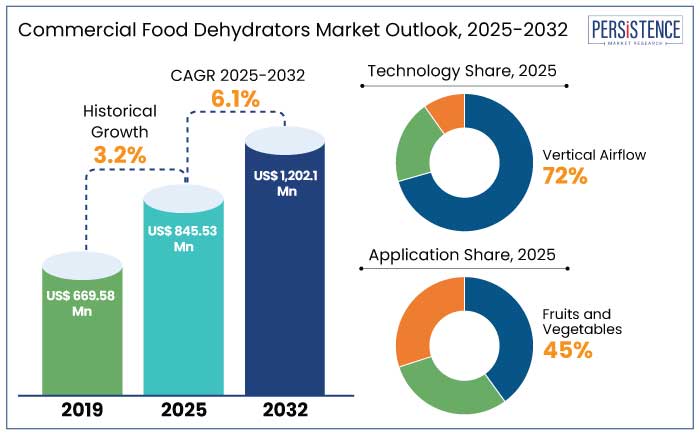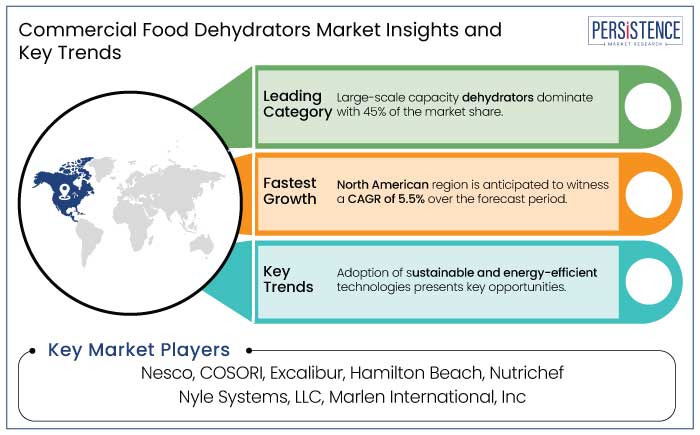ID: PMRREP35058| 190 Pages | 9 Jan 2025 | Format: PDF, Excel, PPT* | Food and Beverages

The commercial food dehydrators market is estimated to increase from US$ 845.53 Mn in 2025 to US$ 1202.1 Mn by 2032. The market is projected to record a CAGR of 6.1% during the forecast period from 2025 to 2032.
According to studies, more than 65% of urban consumers prefer dehydrated snacks like fruits and vegetables due to their portability, long shelf life, and nutritional value, which is one of the key driving elements of the market.
Dehydration can extend the shelf life of surplus or seasonal food by up to 50%, helping businesses reduce food waste and increase profitability. 70% of food processors consider sustainability a key factor when purchasing dehydrators, boosting the demand for energy-efficient models.

Key Highlights of the Market
|
Market Attributes |
Key Insights |
|
Commercial Food Dehydrators Market Size (2025E) |
US$ 845.53 Mn |
|
Projected Market Value (2032F) |
US$ 1202.1 Mn |
|
Global Market Growth Rate (CAGR 2025 to 2032) |
6.1% |
|
Historical Market Growth Rate (CAGR 2019 to 2024) |
3.2% |
North America held a share of 39.2% in 2024. The region has a highly developed food processing industry, which drives significant demand for commercial food dehydrators. It is home to various food manufacturers and processors that use dehydration technologies for preserving fruits, vegetables, meat, and herbs. For instance,
North America is at the forefront of adopting sustainable practices in the food industry, driven by stringent government regulations and consumer demand for eco-friendly products. The U.S. and Canada have implemented energy efficiency standards for food processing equipment, encouraging businesses to adopt renewable-powered and energy-efficient dehydrators.
Companies in the region are adopting solar-powered and hybrid dehydrators to reduce their carbon footprints. For instance,
Farmers and local producers are adopting small-scale dehydrators to preserve surplus produce, reduce waste, and meet the rising demand for local and organic products.
The North America commercial food dehydrators market leads with the most significant revenue share of 38% and is estimated to witness a CAGR of 5.5% over the forecast period. The dominance of North American region is primarily driven by a substantial consumer inclination towards healthy, preservative-free snacks.
With increasing awareness of food waste, numerous individuals and enterprises are utilizing dehydrators to prolong the shelf life of their food items. The region's substantial disposable income enables customers to invest in sophisticated dehydration technology, improving efficiency and quality. Established food processing industries enhance demand as companies pursue creative food preservation and waste reduction solutions.
U.S. commercial food dehydrators led the North American market, accumulating major market share. It is propelled by health and wellness trends that motivate consumers to reduce food waste while preparing nutritious snacks at home.
The growing popularity of home gardening has further contributed to this trend as individuals seek methods to preserve seasonal produce. The growing interest in DIY food preservation methods has increased electric and solar dehydrator sales, appealing to a varied consumer demographic seeking sustainable food alternatives.
Based on technology, the market is further divided into vertical airflow and horizontal airflow. Among these two sub-segments, the vertical airflow sub-segment dominates the market with an estimated market share of 72% in 2025.
Vertical airflow dehydrators are designed with a heat source located at the base or top of the unit, directing air vertically through stacked trays. This configuration ensures that heat is evenly distributed throughout the dehydrator, providing consistent dehydration across multiple layers of stacked trays.
The vertical design optimizes space usage, allowing businesses to maximize their product capacity while maintaining high-quality output. This efficiency particularly appeals to health-conscious consumers and food processors seeking to preserve dehydrated foods' nutritional value and flavour.
The advantages of vertical airflow technology include uniform drying, efficient space utilization, and the ability to handle various food types simultaneously. These benefits have led to widespread adoption in commercial settings, contributing to its significant market share. The design simplicity and cost-effectiveness of vertical airflow dehydrators make them accessible to a range of businesses, from small-scale operations to large food processing facilities.
Based on application, the market is further divided into fruits and vegetables, meats and seafood, herbs and spices, and pet food. Among these application segments, the fruits and vegetables owns 45% of the total market share.
The dominance of fruits and vegetables application segment is primarily driven by the growing demand for dehydrated fruits and vegetables in various sectors, including the food industry, retail, and consumer markets.
The dehydration process removes moisture, inhibiting bacterial growth and spoilage, thereby prolonging the shelf life of produce. Proper dehydration retains essential vitamins and minerals, making dehydrated fruits and vegetables a healthy snack.
The rising consumer inclination towards healthy snacking and the food industry's need for stable, long-lasting ingredients have bolstered the demand for dehydrated fruits and vegetables. The increasing awareness of food waste reduction has led to the adoption of dehydration techniques to preserve surplus produce, further driving market growth.
The commercial food dehydrators market is an integral segment of the global food processing industry, catering to the growing demand for long-lasting, nutrient-rich, and convenient food products.
Dehydration technology plays a vital role in food preservation by reducing the moisture content in food, thus enhancing shelf life while maintaining nutritional value and flavour. The technology is increasingly adopted by industries such as packaged foods, ready-to-eat meals, and specialty health foods, aligning with changing consumer preferences.
Dehydrated food products, including fruits, vegetables, meats, herbs, spices, and pet food, are widely used in various applications such as snack production, meal preparation, and food ingredient manufacturing. The increasing demand for lightweight and portable food solutions, especially among health-conscious consumers, has significantly fuelled the adoption of commercial food dehydrators.
The market is characterized by advancements in dehydration technologies, including vertical and horizontal airflow systems, which offer efficiency, uniformity, and scalability for commercial food processing. Growing awareness of food waste reduction and sustainability has also driven the market, as dehydration is an effective way to preserve surplus or seasonal food for extended use.

During the historical period 2019 to 2024, the commercial food dehydrators market experienced steady growth, driven by the increasing demand for long-lasting and nutrient-rich food products. The adoption of dehydration technology by industries producing packaged foods, ready-to-eat meals, and specialty health foods became a key market driver.
Consumers’ preference for lightweight, portable food solutions, especially in urban and health-conscious demographics, significantly boosted the demand for dehydrated fruits, vegetables, and meats. Advancements in dehydration technologies, such as vertical and horizontal airflow systems, improved energy efficiency and scalability, supporting widespread adoption.
The market is projected to witness accelerated growth post-2025, fueled by technological innovations and sustainability trends. Energy-efficient and eco-friendly dehydrators, such as solar-powered and heat pump systems, are expected to dominate.
Increasing investments in food preservation technologies and the rising demand for organic and preservative-free dehydrated products will further expand the market. Asia-Pacific is anticipated to lead the growth trajectory, supported by industrialization and cost-effective manufacturing.
Rising Demand for Convenient and Nutrient-Rich Food Products Drives Market Demand
The growing preference for long-lasting, portable, and nutrient-dense food solutions has significantly driven the commercial food dehydrators market. Consumers, especially in urban areas, are increasingly opting for snacks like dehydrated fruits and vegetables and ready-to-eat meals, which offer convenience without compromising on nutritional value.
The trend aligns with busy lifestyles and the rising emphasis on healthy eating. Dehydration technology effectively preserves essential vitamins, minerals, and flavours, making it highly suitable for producing high-quality, preservative-free food products.
As consumers become more health-conscious and seek out clean-label, minimally processed foods, the demand for dehydrated food products continues to rise, fuelling the adoption of commercial food dehydrators in various industries.
Advancements in Dehydration Technologies Boosts Market Growth
Innovations in dehydration technologies, such as vertical and horizontal airflow systems, have significantly enhanced efficiency, scalability, and energy consumption in the food processing sector.
Vertical airflow systems, for instance, provide uniform drying and optimize space, making them suitable for large-scale commercial operations. Horizontal airflow systems offer flexibility for dehydrating different food items simultaneously. Modern dehydrators are equipped with digital controls, automation, and energy-saving features, reducing businesses' operational costs.
Introducing solar-powered and heat pump systems further supports the market by addressing environmental concerns and energy efficiency. Such technological advancements enable food processors to meet increasing consumer demand while ensuring sustainable practices.
Recently, Nyle Dehydrators have been at the forefront of introducing heat pump dehydrators that consume up to 60% less energy than traditional drying methods. Their systems offer precise control over dehydration conditions, ensuring optimal product quality while aligning with the industry's shift towards greener practices.
Lack of Awareness and Technical Expertise
One significant restraint on the commercial food dehydrators market is the lack of awareness and technical expertise, particularly in emerging markets and among small-scale food producers. Many businesses and individuals are unaware of the benefits of advanced dehydration technologies, such as improved energy efficiency, consistent drying, and better product quality.
The lack of knowledge can result in continued reliance on traditional food preservation methods, such as freezing, canning, or sun drying, which are perceived as simpler and more cost-effective.
Advanced dehydration systems, such as vertical and horizontal airflow or heat pump technologies, require precise calibration and operational understanding to maximize their effectiveness. Without proper training, users may face issues like uneven drying, energy inefficiency, or equipment breakdowns, leading to dissatisfaction and underutilization of the technology.
Small-scale farmers or food processors in developing economies may struggle to access information, funding, or technical support to transition from traditional methods to modern dehydrators. Addressing these challenges through training programs, outreach initiatives, and user-friendly designs is essential to overcome this restraint.
Adoption of Sustainable and Energy-Efficient Technologies Presents Key Opportunities
Sustainability has become a key driver across industries, and the commercial food dehydrators market is no exception. Adopting energy-efficient technologies, such as solar-powered and heat pump dehydrators, presents a transformative opportunity.
Such systems significantly reduce energy consumption and operational costs while minimizing environmental impact. Governments and organizations promoting green initiatives can accelerate this trend through subsidies and incentives.
Businesses integrating sustainable technologies benefit from lower operational costs and align with the growing consumer preference for eco-friendly practices. It is incredibly transformative in regions with abundant renewable energy sources, such as solar-rich countries in Africa, Asia, and the Middle East.
The commercial food dehydrators market is highly competitive, with key players focusing on innovation, energy efficiency, and sustainability to gain a competitive edge. Prominent companies like Nesco, BioChef, Maan Global Industries, and Tribest lead the market with advanced products such as energy-efficient and digital dehydrators.
The market also sees competition from regional players in emerging economies, leveraging cost-effective manufacturing to cater to local demand. Strategic partnerships, product launches, and geographic expansion are common strategies major players adopt.
Integrating smart technologies and eco-friendly systems has become a critical differentiator. It addresses growing consumer preferences for convenience and sustainability while fostering intense rivalry within the market.
Recent Industry Developments in the Commercial Food Dehydrators Market
The commercial food dehydrators market is estimated to be valued at US$ 845.53 Mn in 2025
The dehydrated food market size is estimated to be valued at US$ 1202.1 Mn in 2032.
The commercial food dehydrators market is estimated to exhibit a growth rate of 6.1% over the forecast period.
Nesco, COSORI, Excalibur, are some of the key players.
North America leads the global commercial food dehydrators market with 38% of the market share.
|
Attributes |
Details |
|
Forecast Period |
2025 to 2032 |
|
Historical Data Available for |
2019 to 2024 |
|
Market Analysis |
US$ Billion for Value |
|
Key Regions Covered |
|
|
Key Market Segments Covered |
|
|
Key Companies Profiled in the Report |
|
|
Report Coverage |
|
|
Customization & Pricing |
Available upon request |
By Capacity
By Technology
By Application
By Region
Delivery Timelines
For more information on this report and its delivery timelines please get in touch with our sales team.
About Author